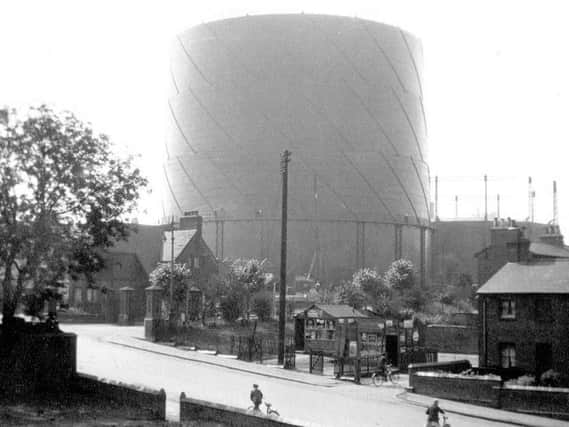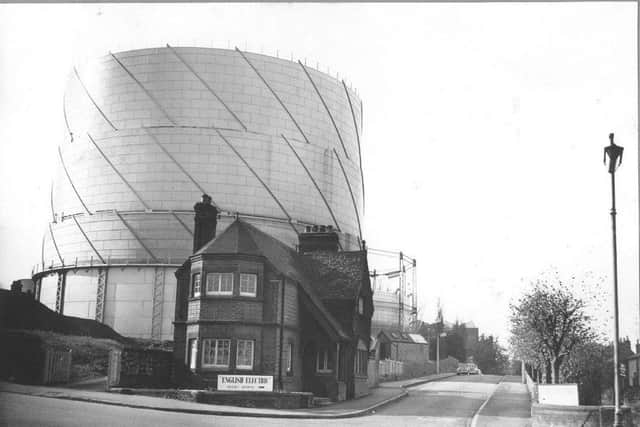Steam trains exhaling cotton wool and a huge spaceship - the vivid memories of the Rugby that once was


One of my earliest memories is that of standing on a heap of grass cuttings at my paternal grandparents’ home in Newbold Road and watching the steam trains cross the bridge.
The sounds, sights and smells linger down the decades. The shush-shush-shush of the locomotive, the clouds of what I thought were actual balls of cotton wool coming out the chimney… the fermented scent of the clippings rising up to greet my young nostrils.
Advertisement
Hide AdAdvertisement
Hide AdI also readily recall the heat of that slowly decaying grass squeezing and oozing between the toes of my red sandals as my feet slowly sank into the heap.


How could this be, I wondered. Why was it warm – hot, even? The other thing that is indelibly burned into my psyche was the sight of this enormous structure, shown in this picture. I really had no idea what it could be.
Perhaps it was spaceship? Or a castle turret? The world of a four-year-old is indeed a very small and mysterious place.
My grandparents lived at a house called ‘Silksworth’ which backed on to Park Walk. On sunny days I would watch the bowlers on the green, dressed in their immaculate whites, sending shiny, black spheres slowly across turf that appeared to have been cut with scissors.
Perhaps that’s where grandad’s clippings came from.
Advertisement
Hide AdAdvertisement
Hide AdNearby was Caldecott Park. How I loved Caldecott Park with its mature trees, perfectly manicured flowerbeds, lawns and its crowning glory, the bandstand. I always thought it was magical place where I might one day encounter Rupert Bear and his strange chums.
On the other side of the park lived my maternal grandmother, at number 58 Regent Street. I have only the vaguest memory of her as she sadly passed away when I was very young.
She had been widowed in 1932. My other grandfather had been a Coventry watchmaker but quit the trade in the 1920s when foreign competition proved too much.
The family bought a poultry farm at Stretton-upon-Dunsmore but the stock was wiped out by disease. Grandad soon died and – this being the 1930s – the family were thrown into poverty.
Advertisement
Hide AdAdvertisement
Hide AdI have no idea how grandmother ended up in Regent Street, which always seemed rather well-to-do. But there you are. She is buried in Whinfield Cemetery.
Back to Newbold Road again, I remember there was a line of terraced houses on the left-hand side after you’d passed under the railway bridge.
They always looked very dingy to me, no doubt because of all the smoke from the steam trains.
The houses had tiny front gardens but I never saw anyone tending them.
Advertisement
Hide AdAdvertisement
Hide AdEven at night, I rarely ever noticed a light being on. To my childlike mind, they always looked rather foreboding. Be that as it may, they have long been demolished.
On the right, there was the Avon Mill pub and swimming baths. You will also remember the public bathing facilities in Regent Street, which featured what were called ‘slipper baths.’
These were used by the poorer people whose homes weren’t plumbed in.
Mind you, we had no piped water at our home in Churchover until 1957.
Advertisement
Hide AdAdvertisement
Hide AdUntil then, our drinking water came from a well in the garden, and as for baths, they were undertaken once a week in a tin tub in front of the fire on a Saturday night before I was allowed to watch Six-Five Special and then
Dixon of Dock Green on our 12-inch Bush television.
I can still feel that abrasive brush coated in carbolic soap scraping across my back as seven days of grime were removed. I haven’t come across carbolic soap for years but vividly recall what it smelled like.
And if you got any in your eye… ouch, that flipping hurts, mum!
Later on, ‘Uncle’ George Hirons might pop over to our house to watch the Saturday night film. It may have been that he hadn’t got a TV at his
Advertisement
Hide AdAdvertisement
Hide AdFive Houses home, but I think it was probably mother’s home-made wine that was the big attraction.
Usually, the film would be an old black and white Western, such as Stagecoach, starring John Wayne as the notorious outlaw Johnny Ringo.
Wish I had a surname like that.
I’ve written quite a lot down the years about ‘Uncle’ George. He was a farm labourer and was as intelligent and resourceful as any man who ever lived. He had a knack of making things out of virtually anything, such as converting spent 12-bore shotgun cartridges into whistles.
That’s another smell I would immediately recognise today – that of gunpowder fumes still lingering in the cartridge. A
Advertisement
Hide AdAdvertisement
Hide Adnumber of village men not only owned shotguns, but could often be seen walking down the street with them ‘broken’. Imagine that today.
This year, I intend to visit Rugby with my younger daughter and to see as many sites as the day will allow. There will be Whinfield and Clifton Road cemeteries to visit among several other places.
And if there’s time, we will walk down Newbold Road and past ‘Silksworth’ where I stood on the heap of clippings and watched the steam trains… all those years ago.
Beef Cubes and Burdock, John Phillpott’s book about his childhood, is available from booksellers and online.